 |
Consequences of Vatican II
The Perplexing Pontificate
of Pope John Paul II
Dr. Remi Amelunxen
Dr. Amelunxen is a Professor Emeritus in the Department of Microbiology and Molecular Genetics at the University of Kansas School of Medicine
On a recent pilgrimage to Spain and France, I had occasion to converse many times with a very nice and well-informed Catholic lady from the United States who was concerned about the crisis inside the Church. While she was willing to admit that John Paul II did some things that were harmful to the Catholic Faith and questionable in orthodoxy, she insisted that he was a holy Pope and not fully responsible for any such actions. Rather, he was being manipulated by progressivists in the Vatican who did things without his knowledge and were coercing him to advance Progressivism. Therefore, he was a trusting pawn, and probably did not even realize all the bad consequences of his acts.
This is the same excuse used consistently for JPII, and I think it is time to put it to rest. Clearly, he was a progressivist thinker before he became Pope, and afterward during his pontificate. Some of these data may shock readers a bit, but all are based on fact, not fiction. Much of the information presented here is documented in the book The Undermining of the Catholic Church by Mary Ball Martínez (3rd ed., 1998), which is one of the most important books revealing the pre-planned devastation of the Catholic Church.
I have been fortunate to have reviewed all of Atila S. Guimarães’ books over the years. He is a brilliant Brazilian author, and his masterpieces are In the Murky Waters of Vatican II and Animus Delendi I and II (Desire to Destroy I and II). Should you want a plenitude of facts about the planned destruction of the Church and the salient role the last Popes played in this revolution, I highly recommend that you get them and read them. They are detailed and fully documented.
What follows is a selected resume of Karol Wojtyla’s personal history with facts clearly recorded in many books and publications. It demonstrates that he was not manipulated, bamboozled, coerced, intimidated, or whatever else, either before or during his Papacy. Cardinal Ratzinger was also involved in many of John Paul II’s destructive activities as head of the ex-Holy Office, now called the Congregation for the Doctrine of the Faith.
I truly wish the following were not true but one cannot hide one’s head in the sand and fight reality when it is clear that the Great Apostasy foretold in the Third Secret of Fatima to have been released to the world in 1960 is now at its peak.
Wojtyla's thinking before the papacy
Here is a short summary of the thinking of Karol Wojtyla prior to his Papacy:
1. He was known for his early involvement with a kind of theosophical “know thyself” philosophy [click here] along the lines of Rudolph Steiner, the liberal thinker who greatly influenced Angelo Roncalli (Pope John XXIII).
Cardinal Wojtyla camping with youth of both sexes [for more, click here] - Oddi, January 26, 1979 |
2. He pursued studies of Thomistic theology under Archbishop Sopieha in Krakow, which seemed to be an exercise in futility because like many in the Rhine group (e.g. Rahner and Küng) he did not hesitate to denigrate St. Thomas’s Summa and Scholasticism.
3. He studied at the progressivist Louvain University in Belgium, a leading center for radical theological ferment. Karol was a proponent of these teachings and part of the Priest-worker movement (Communist-inspired) prevalent at that time.
4. Fr. Wojtyla spent two years preparing a thesis on the man-centered philosophy of Max Scheler, a German-Jew philosopher who after being a Catholic for a few years, reverted to rigid Atheism.
5. He found a new philosophical fascination in the Phenomenology of Rahner, Küng and Dulles and the Existentialism of Maritain and Von Balthasar – most of whom proclaimed heresy (e.g. by the denial of the Divinity of Christ and Transubstantiation).
6. In 1956 Fr. Wojtyla became a Bishop – at that time two of his books were published: the Max Scheler thesis and a very questionable book on marriage.
7. At Vatican II he and Fr. Ratzinger worked on the Constitution Lumen gentium. In it is stated that the Church of Christ subsists in the Catholic Church and, therefore, that the Church of Christ is not just the Catholic Church! Wojtyla was also a member of the commission that drafted the Constitution of Vatican II Gaudium et spes (The Church in the modern world), an insidious document, to say the least.
Later, Cardinal Joseph Ratzinger would affirm that the principles of adaptation to the world in Gaudiun et spes and of religious liberty formed a type of counter-Syllabus [click here]
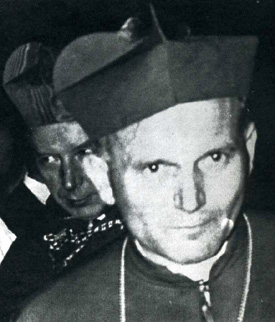
In 1967 Paul VI made progressivist Wojtyla a Cardinal |
8. At Vatican II, Archbishop Wojtyla commented on missionary activity in the Church: “It is not the role of the Church to lecture unbelievers. We are engaged in a search along with our fellow men – let us avoid moralizing or the suggestion that we have a monopoly on truth.” The great Missionary Fathers of the past must have wept in Heaven. As Pope he repeated this in his encyclical Ut unum sint and spoke often of the possibility of the universal salvation of all men. For example, in his encyclical Redemptoris Missio, he stated that “salvation is accessible in mysterious ways – even to those who are not members of the Church or have not received the Gospel proclamation - insomuch as divine grace is granted to them by virtue of Christ's redeeming sacrifice.”
9. He removed from Gaudium et spes (despite the objection of Czech Archbishop Hnilica) any condemnation of the horror of Atheistic Communism. For that brilliance, he was made a Cardinal by Paul VI in 1967.
10. Cardinal Wojtyla explained to Paul VI that downplaying the Ukrainian Uniate Catholic Church, in favor of the Soviet KGB “Orthodox Church” was a goal he should pursue via Cardinal Casaroli (an alleged Freemason). Vatican Ostpolitik became an obsession thereafter.
11. At the 1974 Synod in Rome, a call for the “evangelization of love” was made and Cardinal Wojtyla acted as official theologian for the notably very progressivist Cardinal Etchegaray of Marseille. His introductory talk reeked of Maritain’s Integral Humanism; then later he emphasized the thoughts of the Austrian Jesuit Joseph Jungman who urged “a rejection of the sterile transmission of dogmatic theological teaching.”
In 1978 on October 16, Karol Wojtyla was elected to the Chair of Peter. Was he, finally, a bona fide Traditionalist who had reached the top? I’m afraid not. Seriously, many prayers were offered for him to the Blessed Mother and the Holy Ghost to shed enlightenment on his thinking
Landmarks of John Paul II's pontificate
What follows is a short summary of the pontificate of John Paul II:
1. He took as his motto, Totus Tuus [Totally yours, Blessed Mother]; but not to the extent that he was willing to obey her mandate at Tuy in 1929 to Sister Lucia to consecrate Russia to her Immaculate Heart in union with the Bishops of the world.
A brief historical background on this important heavenly mandate is in order. It is known that Pope Pius XI knew about this command by the Mother of God six to eight weeks after Tuy in 1929, but Vatican Ostpolitik was already in progress via Cardinal Tisserant, the predecessor of Casaroli, who wanted to avoid hurting the feelings of the Russian “Orthodox.” If Pius XI would have obeyed, it is worth pondering the outcome: no World War II or subsequent wars involving hundreds of thousands of lives; Russia would be converted; many souls would have gone to Heaven instead of Hell, etc. Instead, we have had 77 years of disobedience by Popes to the Blessed Mother of God! JPII could have prevented both Iraqi wars and much of the above. It is a sickening scenario.
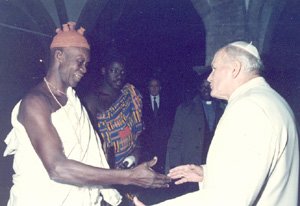
JPII greets a voodoo witch doctor in Assisi I [click here] |
2. The religious encounters at Assisi I and II comprise a horror story which is well known. At Assisi I in 1986, the Buddhists, led by the Dalai Lama, quickly converted the altar of the Church of San Pietro by placing a small statue of the Buddha atop the Tabernacle and setting prayer scrolls and incense burners around it. It was a high level sacrilege. And, more recently, we have Hindus praying to their gods on the Cova da Iria altar at Fatima.
3. Under JPII, capital punishment became a sinful act in contrast to Sacred Tradition and the consistent teaching of the Church, which says otherwise.
4. Regarding evolution, JPII gave a talk to the Pontifical Academy of Sciences implicitly endorsing evolutionism and going beyond what was expressed by Pope Pius XII in Humani generis with regard to it. Pius XII referred to evolution as a “serious hypothesis” worthy of further research and reflection. Pius XII also stressed the essential point: “if the human body takes its origin from a pre-existent living matter, the spiritual soul is immediately created by God.”
JPII went beyond this by saying that “today almost half a century after the publication of the Encyclical, new knowledge has led to the recognition of more than one hypothesis in the theory of evolution. It is indeed remarkable that the theory has been progressively accepted by researchers following a series of discoveries in various fields of knowledge. The convergence neither sought nor fabricated of the results of work that was conducted independently is in itself a significant argument in favor of this theory” (cf. Inside the Vatican, January 1997, pp. 26-9).
Thank you, Darwin, Teilhard de Chardin, Pius XII and JPII for helping to destroy the Catholic doctrine of creationism!
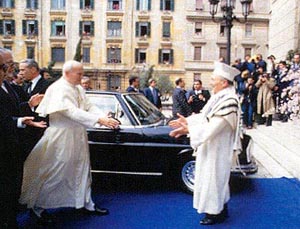
JPII embraces the rabbi of Rome at his visit to the Synagogue of Rome in 1986. [click here] |
5. According to JPII’s teachings, we Catholics worship the same God as the Islamics and Jews! JPII said this and reiterated it in the un-Trent-like Catechism of the Catholic Church, based mainly on Vatican II. This is a denial of Christ and the Trinity, Who are clearly rejected in these religions.
Under the heading The Church’s Relationship with the Muslims in the above-mentioned Catechism (1994, with an imprimatur by Joseph Cardinal Ratzinger and approved by Pope John Paul II), it states: "The plan of salvation also includes those who acknowledge the Creator, in the first place amongst whom are the Muslims; these profess to hold the faith of Abraham and together with us, they adore the one merciful God, mankind's judge on the last day”" (p. 223, 841). The Jews also adore the God of Abraham!
6. He kissed the Koran in which it is stated that the Trinity is an abomination, and that Christians are infidels who should be destroyed. How can ecclesiastics and high level politicians consider it a text of peace? After he kissed the Koran, he approved the new mosque in Rome.
7. In a talk given to Jewish rabbis, when asked about the Catholic belief in the Messiah in relation to the Jews, he answered, to paraphrase, that we have had the Messiah as Christians, but the Jews are yet awaiting their messiah – we can’t fault them for this. How could he forget the prologue of St. John: “He came into His own and His own received Him not.”
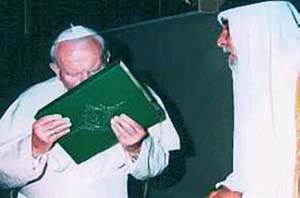
In May 1999 John Paul II kisses the Koran at the Vatican [click here] |
Further, the Catechism of the Catholic Church states: “And when one considers the future, God’s people of the Old Covenant and the new people of God tend towards similar goals: expectation of the coming (or the return) of the Messiah. But one awaits the return of the Messiah who died and rose from the dead and is recognized as Lord and Son of God. The other awaits the coming of a messiah, whose features remain hidden till the end of time, and the latter waiting is accompanied by the drama of not knowing or misunderstanding Christ Jesus” (p. 223, 840).
8. The World Youth Days inaugurated by JPII turned out to be immoral and ecumenical events celebrating all the religions. It seems that it did more to incite lust and the cultural revolution in the masses who camped out together than an authentic religious spirit.
9. On more than 100 occasions, according to the Italian journalist Luigi Accattoli, Pope John Paul II has publicly admitted that the Catholic Church was guilty of errors in the past. Among the Church's supposed errors for which John Paul apologized are the Church’s previous condemnations of heretics and schismatics, conversions, the ecclesiastical use and approval of force, and the anti-Jewish religious polemic. He also made apologies for the supposed harsh treatment of Galileo, the existence of the Inquisition, and the convocations of the Crusades [See Why Apologize for the Crusades at the end of this article] .
For example, regarding Galileo, the scientist involved himself with false theology in his scientific pursuit and was “chastised” by living in luxury for over a year in the Palace of the Archbishop Piccolomini of Siena.
10. In 2000 JPII endorsed a fraudulent version of the Third Secret, delivered to him by Cardinals Sodano, Ratzinger, Hoyos, and Archbishop Bertone. The Third Secret was inferred by Frs. Fuentes and Alonso who were close to Sister Lucia, and by Bishops Venancio and da Silva of Fatima. Cardinals Ottaviani, Oddi, Ciappi and Biffi, and even the liberal Cardinal Bea and his aíde, Fr. Malachi Martin read the Third Secret.
All referred to the “great apostasy” in talks about the contents of the Secret. Ottaviani mentioned it four times in one talk, and Fr. Martin said it also included mention of chastisement. Cardinal Mario Ciappi, papal theologian under Paul VI and John Paul II, wrote this: "In the Third Secret it is foretold, among other things, that the great apostasy in the Church will begin at the top.”
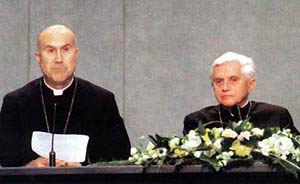
Cardinals Bertone and Ratzinger supported the false Third Secret released by JPII in 2000 |
Pope JPII, Cardinals Sodano, Ratzinger, Hoyos, and Bertone (now a Cardinal) fabricated a new Third Secret in 2000 by proposing that it was an assassination attempt on JPII, which absolutely does not fit with anything released about it before. Even liberal secular sources expressed skepticism about that fraudulent exposé.
Pope Benedict stated clearly that Fatima was over, although he said otherwise about seven years ago. Without release of the Third Secret to the world and the Consecration of Russia as mandated by the Blessed Mother of God, how could Fatima be over?
11. In Fatima in Twilight by Mark Fellows (published at the Fatima Center in 2003 by Fr. Gruner), Sister Lucia told Fr. Alonso: “The final triumph of Mary’s Heart is certain and it will be definitive. But it will take place ‘in the end,’ that is, to say after a terrible purification of sinful humanity in a baptism of fire, blood and tears.” One can certainly surmise this means after the chastisement.
Of course, the party line is that the Consecration was made in 1984, 22 years ago. The level of morality in Russia is now in severe decline. Would this dismal state of affairs signal the conversion of Russia promised by Our Blessed Mother at Fatima after the country is consecrated to Her Immaculate Heart?
John Paul II's contradictions
The following are two examples of Pope John Paul II’s blatant contradictions to dogmatic infallible teachings:
A. The doctrine of Justification
Regarding the dogma of Justification, the following definitions are found in A Catholic Dictionary by Donald Atwater:
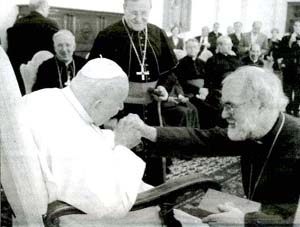
JPII kisses the hand of Anglican head Rowan William at the Vatican in October 2003 - NCR, October 17, 2003 |
“Justification in its active sense is the act of God declaring and making a person just: in its passive sense it is the change in a soul which passes from the state of sin to that of sanctifying grace (q.v.) or justice. At the time of the Reformation, the following Protestant errors became current:
a. Faith alone is the necessary disposition for justification;
b. Justifying faith is a mere confidence in the Divine Mercy;
c. Justification is separable from sanctification: it is a mere judicial declaration that the sinner will not be punished and that sanctification itself is but a cloaking of sin and an extrinsic imputation of the merits of Christ.”
The definition for Justification by faith (Atwater) is this:
“Faith is a necessary condition of justification. That faith alone justifies is a heresy of Luther condemned by the Council of Trent (session VI, can 9, de justificatione): ‘If anyone shall say that the wicked man is justified by faith alone, meaning that no other thing is required to cooperate for obtaining the grace of justification, and that it is not necessary for him to be prepared and disposed by the movement of his will, let him be anathema.’”
The definition for Justification by works (Atwater):
“Justification by faith alone is not possible. Other dispositions of the soul, works done under the influence of grace, such as fear, hope, charity, hatred of sin, are necessary. Such is the clear doctrine of Scripture: ‘Do you see that by works a man is justified, and not by faith alone? …. Faith without works is dead’ (James 2:24, 26).”
The above definitions are clearly reiterated in Fundamentals of Catholic Dogma by Dr. Ludwig Ott (4th ed., 1960, pp. 250-54), and in the Dogmatic Canons and Decrees of the Council of Trent and Vatican Council I (originally published in 1912, reprinted by Tan Books and Publishers, 1977, pp. 49-57.)
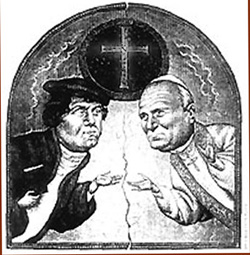
Time magazine shows John Paul II approaching Luther regarding the doctrine of justification in the Augsburg Accord - Time, July 6, 1999 |
Regarding the dogma of justification in the signing of the Catholic-Protestant accord in Augsburg on October 31, 1999: Atila Guimarães points out in his analysis of the documents [click here] that the document key phrase (paragraph 15) affirms the need for grace and faith to achieve salvation:
“Together we confess that we are accepted by God and we receive the Holy Spirit, who renews our hearts, empowers us, and calls us to do good works, not on the basis of our merits but only through grace and faith in the salvific work of Christ.”
This agreement, which in effect denies the need for good works and accepts Luther’s version of justification by faith alone flies in blatant contradiction to the condemnation of the errors of Luther at two Ecumenical Councils: the Fifth Lateran Council and the Council of Trent. Even a Pope cannot revoke the perennial teaching of the Catholic Church, i.e. infallible pronouncements of Dogmatic Councils, ex cathedra papal pronouncements and Sacred Scripture.
As John Vennari points out in Pope John Paul II and the Lutheran-Catholic Accord:
“The goal of this ecumenical dialogue and the Joint Declaration is an attempt for Lutherans and Catholics to reach a common understanding on the doctrine of justification – how man is made ‘just’ in God’s eyes. Anyone with a rudimentary knowledge of the difference between Catholic doctrine vs. Lutheran teaching on justification will recognize immediately the impossibility of achieving a common understanding. The two teachings are diametrically opposed” (TIA, 2003, p. 4).
B. Extra Ecclesiam nulla salus (No salvation outside the Church)
Of all the Catholic dogmatic teachings, this one has been the subject of much controversy and interpretations, ranging from rigid to moderate, but none even remotely approach the concept proposed by John Paul II of universal salvation.
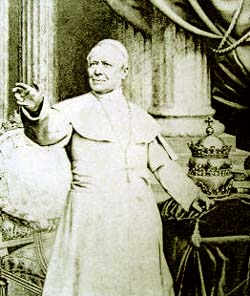
Pius IX clearly reiterated Catholic teaching on no salvation in false religions |
There are three pronouncements categorized as ex cathedra on the dogma Extra ecclesiam nulla salus. The first was made by Pope Innocent III at the Fourth Lateran Council in 1215; the second by Pope Boniface VIII in the Bull Unam Sanctam in 1302, and the third and by far most encompassing by Pope Eugene IV in the Bull Cantate Domino in 1441 just prior to the Council of Florence in 1442.
Blessed Pope Pius IX forcefully reiterated Extra ecclesiam nulla salus in the following statement: “We must mention and condemn again that most pernicious error, which has been inhibited by certain Catholics who are of the opinion that those people who live in error and have not the true Faith and are separated from the Catholic unity, may obtain life everlasting. Now this opinion is contrary to Catholic Faith, as is evident from the plain words of Our Lord (Mt. 18:17, Mk 16:16, Lk 10:16, Jn 3:18), as also from the teaching of St. Paul (2 Tim 3:11) and of St. Peter (2 Pet 2:1). To entertain opinions contrary to this Catholic Faith is to be an impious wretch” (apud Michael Muller: The Catholic Dogma, NY: Benzinger Bros, 1888, p. xi).
A Catholic Dictionary (Atwater) states that Outside the Church there is no salvation refers to those who are outside the Church by their own fault. There is a command to enter the Church which is the prescribed way to Heaven. He who refuses to join the Church which Christ founded, commanding adhesion to her, is on the way of perdition. But those who are in invincible ignorance will not be condemned on account of their ignorance. There has been much discussion on the issue of invincible ignorance and on the Baptisms of desire and blood, which would be the topic of another article.
The Encyclical Ut unum sint of JPII, however, jumps past this discussion and proclaims universal salvation, completely contradicting the entire spectrum of interpretations of the dogma Extra ecclesiam nulla salus. The details of what many consider to be the most radical of all papal encyclicals are clearly delineated in Quo Vadis, Petre? by Atila Guimarães (Los Angeles: TIA, 2001, pp. 45-52).
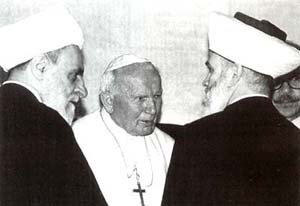
John Paul II meets with Muslim leaders on his trip to Lebanon - Catholic World Report, July 1997 |
As pointed out by the author, revolutionary proposals by JPII include the creation of a “common martyrology” containing “saints” from Catholic, so-called Orthodox and Protestant religions, the beatification of heretics who were condemned for their doctrines (e.g. Girolamo Savonarola and Giordano Bruno), the affirmation that other religions are a normal and legitimate means to salvation, and that the Vatican’s total dedication to ecumenism is irrevocable.
In Pope John Paul II and the Lutheran-Catholic Accord, John Vennari writes that in a shocking statement JPII says that “it is a source of joy” that in some circumstances non-Catholics who have no intention of converting to the Catholic Church may now receive the Eucharist” (p. 10).
In addition, JPII mandates ecumenism into every aspect of Church life, and encourages numerous unprecedented interfaith practices that have always been condemned by the Church as grave sins against the Faith. Universal salvation really denies the necessity for Baptism, denies original and mortal sin, and strongly suggests a denial of Hell. Sanctifying grace seems to be present in all of mankind.
False ecumenism
Pope JPII has abandoned dogmatic infallible teachings that come from de Fide infallible pronouncements by Popes or Councils to promote a false ecumenism. As St. John says: “Other sheep I have that are not of this fold: them also I must bring, and there shall be one fold and one Shepherd” (10:16). The meaning is clear that conversion of all men is the goal of Christ, not through dialogue and concession, which is the very essence of false ecumenism.
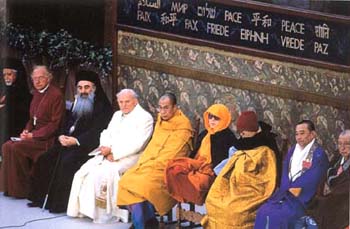
An unprecedented event: JPII convokes the heads of many false religions to pray together at Assisi, 1986 |
The Doctors of the Church are harsh in their condemnation of Popes and other ecclesiastics who contradict the extraordinary infallible Magisterium, which in Dogmatic Theology is untouchable. Is it possible that JPII with his extensive background was unaware of his dogmatic errors? It is highly unlikely.
As defined in A Catholic Dictionary (Atwater), “Heresy consists in the formal denial or doubt by a baptized person of any revealed truth of the Catholic Faith; as a crime it consists of the outward and pertinacious manifestation of the sin.” Anyone guilty of the crime of a defined heresy incurs excommunication ipso facto. The Council of Trent is replete in using the word anathema to signify the most severe form of excommunication.
St. Thomas defines heresy as “a species of infidelity in men who having professed the Faith of Christ, corrupt its dogmas. The right Christian faith consists in giving one’s voluntary assent to Christ in all that truly belongs to His teaching. The believer accepts the whole deposit as proposed by the Church; the heretic accepts only such parts of it as commend themselves to his own approval.” (II-II, q. 11, a in The Catholic Encyclopedia, 1911, vol. 12, p. 256). Further on, it is stated: “Pertinacity, that is, obstinate adhesion to a particular tenet, is required to make heresy formal” (ibid).
The Novus Ordo Mass
The disaster of Vatican Council II is clear and unambiguous. If anyone should doubt this, let him please read In the Murky Waters of Vatican II and Animus Delendi I and II by Atila Guimarães. You will no longer have any doubts!
Regarding the Novus Ordo, some explanations would be in order. The theological aberrations are replete ad nauseam. Suffice it to say, the ICEL version of the consecratory formula for changing the wine into the Precious Blood is invalid. The Council of Florence in 1442 (Pope Eugene IV) dogmatically and infallibly pronounced the consecratory formulas for the bread and wine used in the Tridentine Mass. The Council of Trent (1545-63) did likewise and much more in Session 22. The absence of the words pro multis and Mysterium Fidei (Transubstantiation) invalidates the form of the Novus Ordo. ICEL falsely claimed there was no word for “many: there are actually two words in Aramaic for “many” and two for “all” according to several linguistic scholars. The Council of Trent forbade the use of the word “all” because “all” do not belong to the Mystical Body of Christ. In addition, as an aside (Session 22, Chapter VIII), stated clearly that the Mass may not be celebrated in the vernacular.
Some traditional theologians argue that given a priest who has intentio interna (i.e. the intention to Transubstantiate), has the proper matter (unleavened bread), and does not recognize true error(s) in the form, then God’s mercy allows such a Mass to be valid. I pray they are correct. When Pope Paul VI and Msgr. Bugnini (and six Protestant ministers) formulated the Novus Ordo, they totally contradicted two infallible dogmatic Councils and Paul VI acted ultra vires (outside of his authority) in propagating this Mass.
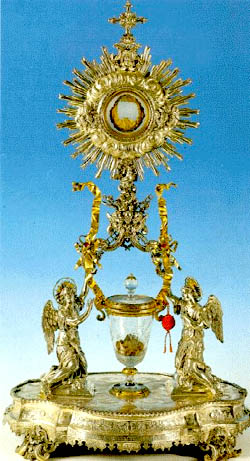
The miraculous Host and Precious Blood of Our Lord at Lanciano |
Many theologians and pastors, including Archbishop Marcel Lefebvre, estimate more than 60 % of the Novus Ordo Masses are invalid because so many priests deny Transubstantiation and believe in transignification as taught by the heretic Hans Küng. According to Küng, in “transignification,” Christ would be in the bread and in the wine not as a physical reality, but only in the sense that they are signs of Christ for the community. Other denials of Transubstantiation include “transfinalization” and even those who believe that Transubstantiation is a cannibalistic act!
It is often stated that if a priest intends to do what the Church does (de Fide) there is no problem with the validity of the Sacrament, implying that disbelieving priests necessarily do this and therefore, validity is no problem. Logic alone would certainly suggest that if a priest denies the Real Presence (and in fact may detest the dogma) and believes in transignification or some other aberration, then it is not likely that he intends to do what the Church does!
My suggestion to anyone (both clergy or laity) who doubts Transubstantiation is to study the details of the majestic Miracle at Lanciano, Italy. A short summary is in order. In about the year 700 in the Monastery of St. Longinus, a priest of the Order of St. Basil was celebrating the Holy Sacrifice of the Mass according to the Latin Rite (the Gregorian Sacramentary). Having had recurring doubts about Transubstantiation, he had just completed the Consecratory formulas (same as the Tridentine Mass), when the host was changed into flesh, i.e. the myocardium which is the lining of the heart, and the wine was changed into blood (rare AB type), which subsequently formed five clots signifying the five Wounds of Christ.
The center of the Sacred Host remained bread, and rapidly decayed, but the large circle of the myocardium and the five clots of blood are perfectly preserved even though neither was hermetically sealed, which comprise another great miracle.
Scientific tests have consistently proved over the centuries that the combined weight of the five clots of blood was equal to the individual weight of any one of them. An extensive scientific investigation in 1970-71 provided a certain and thorough endorsement of the authenticity of the Eucharistic Miracle. Lanciano tradition is firm in the belief that when receiving Holy Communion, we receive the Divine Sacred Heart of Jesus and His Precious Blood from that Heart! An awe-inspiring conclusion where proof lies in the very nature of the great Eucharistic Miracle.
Recent proposed changes in the Novus Ordo liturgy, while perhaps enhancing the reverential aspect of the Novus Ordo, will most likely not correct the dogmatic error in the consecratory formula of the wine and many other significant aberrations.
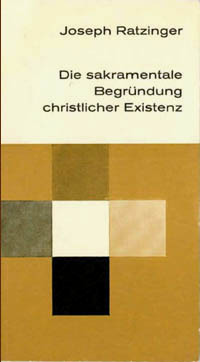
Ratzinger's book in which he denies the Real Presence is still sold today |
Finally, I offer a shocking quote from Bishop Ratzinger’s book Die Sakramentale Begründung Christlicher Existenz, [The Sacramental Reason for Christian Existence] which is still on the shelves in Germany. To date he has never denied the following passage:
“Eucharistic devotion such as is noted in the silent visit by the devout in church must not be thought of as a conversation with God. This would assume that God was present there locally and in a confined way. To justify such an assertion shows a lack of understanding of the Christological mysteries of the very concept of God. This is repugnant to the serious thinking of the man who knows about the omnipresence of God. To go to Church on the grounds that one can visit God who is present there is a senseless act which modern man rightfully rejects.” (Freising-Meitingen, Germany: Kyrios Pub., 1966)
Is this what the Holy Catholic Church has taught since apostolic times about the Real Presence, Body and Blood, Soul and Divinity of Jesus Christ in the Blessed Sacrament? Obviously not.
More recently, on the feast of Corpus Christi, Pope Benedict XVI told 30,000 people in St. Peter’s Square “to nourish themselves frequently with the Body and Blood of Christ, our spiritual food” (Zenit, June 14, 2006). The term “spiritual food” has been used ambiguously in the progressivist Church. Canon VIII from the Council of Trent states this on the Most Holy Sacrament of the Eucharist: “If one saith that Christ, given in the Eucharist is eaten spiritually only and not also sacramentally and really, let him be anathema.”
Let us hope that the Pope has had a theological change of heart from what he stated in his book Die Sakramentale, and that by his use of “spiritual food” he truly agrees with the meaning so stated in Canon VIII.
The above historical events incite great sadness in Catholics who love the Church. But sadness must never succumb to despair because of the promise in Sacred Scripture: “The gates of Hell shall not prevail against her.”
May Our Lord, through the intercession of His Holy Mother and the great St. Joseph, restore the One Holy Catholic and Apostolic Church to its once glorious state!
My gratitude to Atila Guimarães and Marian Horvat for assisting me with this manuscript and for putting it on their Tradition in Action website

Posted August 7, 2006
|
Why Apologize for the Crusades?
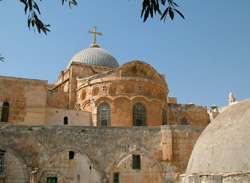
The Crusaders Reconstructed the Church of the Holy Sepulchre in the 12th Century |
Without the Crusaders, the Holy Land would be devoid of Sacred History. The Church of the Holy Sepulcher in Old Jerusalem stands over Golgotha, the place of the skull, because this solid rock hill is shaped like a skull and according to Holy Land tradition, Adam’s skull was found next to the Cross of Jesus. The Emperor Hadrian built a temple to Venus that marked the spot for St. Helena, and a statue of Jupiter was placed over the 6” diameter hole in the rock where the Cross with Christ nailed to it was dropped with violence. The hole is about 12-14” deep.
The age-old mystery of how Our Lord could have suffered with overwhelming intensity both mentally and physically is unanswered in Sacred Scripture and Dogmatic Theology. The answer is given unequivocally by Ven. Mary of Agreda in her magnificent series entitled The Mystical City of God (4 vol.), dictated to her by the Blessed Mother in person. The first Pope officially to recognize the work was Innocent XI who gave his approval for publication and reading in 1686 in response to virulent attacks against it by the Jansenists. The Mystical City of God is not de fide, and therefore belief in it is not mandatory. Nevertheless, it has received multiple imprimaturs, the approbation of 32 Popes, and Pope St. Pius X so loved it that he urged frequent reading of the work by clergy and laity.
Ven. Mary of Agreda explains the excessive suffering of the Agony in the Garden of Gethsemane by stating that Christ, the God-Man disbanded his Divinity to agonize in his human nature to the fullest extent at the vision of the enormity of physical suffering that He was about to undergo in His Passion and Crucifixion.
In explaining how Christ could bodily survive the enormity of such physical suffering the Mystical City states that the God-Man used his Divinity to enable Him to suffer to a point approaching infinity. A full description of such suffering, which is beyond human comprehension, is given by Ven. Mary of Agreda and by Blessed Anna Catherine Emmerick. The average human being would have expired within minutes after the brutality inflicted just in being dragged across the Kidron Valley from the Garden of Gethsemane to the house of Caiaphas. Let us meditate often on the Agony in the Garden and the Passion and Crucifixion of Jesus Christ!
In 325-6, St. Helena, mother of Constantine, found the true Cross, the crosses of Dismas and Gesmas, the Crown of Thorns, the nails used to crucify Christ, and the skull of Adam. She ordered her son to tear down the pagan temple and build a Basilica over Golgotha. This Basilica and seven subsequent ones were destroyed by the Islamics (mainly Persians). The one standing there now was built by the Crusaders in 1192. And we should apologize for the Crusades?
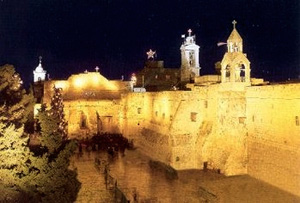
The Church of the Nativity at night |
One beautiful story needs to be told. In Bethlehem stands the Church of the Nativity. St. Helena found the cave of the Nativity in 326-7, which was marked by a temple to Adonis over it. Constantine destroyed the pagan temple and built the Church there now– it was completed in about 401 according to some historians. St. Jerome wrote the Latin Vulgate from a cave next to the place where Christ was born.
Why didn’t the Persians destroy this magnificent structure of Constantine? They came to do so in the 7th century and, Deo gratias, a large fresco of the three Magi dressed in Persian garb was over the entrance to the Church. They looked in bewilderment and left it untouched.
Clearly the Crusaders understood the importance of these places where Our Lord Jesus Christ lived, taught, suffered and died. They were willing to risk their lives to save those Sacred Places, they rebuilt a great number of them that were destroyed, and maintained the Holy Land as a safe pilgrimage site for the Catholic faithful. How could JPII apologize for the enormity of their valiant work?
R.A.
|

Related Topics of Interest
 Is the Catholic Church Becoming a Branch of the Synagogue? Is the Catholic Church Becoming a Branch of the Synagogue?
 The Canonization of Wojtyla - the Moral Free Pope The Canonization of Wojtyla - the Moral Free Pope
 The End of the Myth of Galileo The End of the Myth of Galileo
 John Paul II Being Lectured by a Polish Rabbi John Paul II Being Lectured by a Polish Rabbi
 The October Revolution & Non Possumus The October Revolution & Non Possumus
 The Bad Effects of the Papal Apologies The Bad Effects of the Papal Apologies

|
Vatican II | Hot Topics | Home | Search | Books | CDs | Contact Us | Donate

© 2002-
Tradition in Action, Inc. All Rights Reserved
|
 |
|